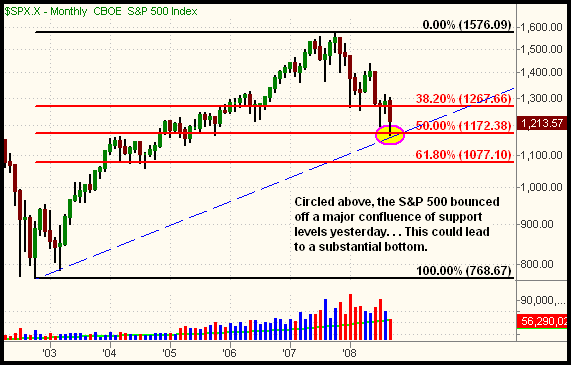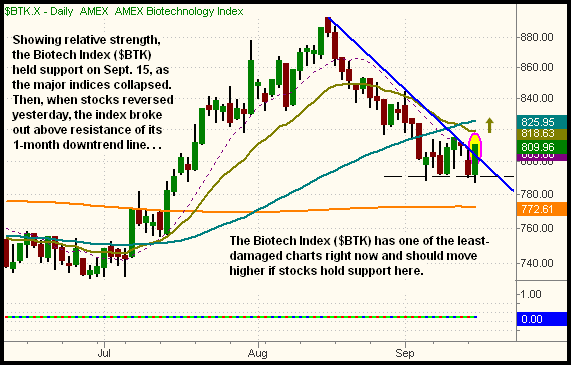|
The Wagner Daily ETF Report For September 17
With the major indices down approximately 2% just a few minutes after yesterday's open, investors might have expected a repeat performance of Monday's plunge, but yesterday's action played out much better. The main stock market indexes reversed their morning losses, rising to unchanged levels just before mid-day. At 2:15 pm ET, the Fed stated in their announcement on economic policy that interest rates would remain unchanged, initially causing stocks to fall back to nearly test their morning lows. But the bulls showed late-day resilience, propelling the major indices to new intraday highs in the final ninety minutes of trading. The S&P 500 climbed 1.8%, as both the Nasdaq Composite and Dow Jones Industrial Average rallied 1.3%. Small and mid-caps showed the most relative strength. The Russell 2000 and S&P Midcap 400 indices gained 3.0% and 2.1% respectively. Each of the main stock market indexes closed near its best level of the day.
It was a very active day on Wall Street. Total volume in the NYSE soared 25% above the previous day's level, marking the highest daily turnover in about seven months. Trading in the Nasdaq exchange similarly ticked 20% higher. The broad market's higher volume gains enabled both the S&P 500 and Nasdaq Composite to score a bullish "accumulation day," the second such instance of institutional buying within the past week. The first "accumulation day" was on September 11, a bullish reversal day that was subsequently invalidated by the September 15 sell-off. Decent market internals matched yesterday's gains. In both the NYSE and Nasdaq, advancing volume exceeded declining volume by approximately 2 to 1.
In yesterday's newsletter, we illustrated, on the long-term monthly chart, the key area of support the S&P 500 was approaching. Specifically, we showed how convergence of the 50% Fibonacci retracement and 14-year uptrend line was just 1.7% below Monday's closing price. It's not surprising, therefore, that the S&P 500 reversed after coming into support of that convergence on yesterday's open. Taking an updated look at the monthly chart, you'll see the perfect bounce off the convergence of support:

Before this month's sell-off began, biotechnology was one of the leading industry sectors in the stock market. The biotechs lost a bit of their relative strength as the going got rough, but the sector has again begun to display a lot of relative strength over the past two days. To illustrate this, take a look at the daily chart of the Amex Biotech Index ($BTK) below:

The most obvious occurrence on the $BTK chart above is that the index broke out above resistance of its one-month downtrend line yesterday. However, there is another subtle point that hints at its relative strength. On September 15, all the main stock market indexes convincingly broke down to fresh 52-week lows. But notice that the $BTK merely held support of its short-term trading range. This basing pattern, backed by relative strength, should lead to further gains on the breakout above its downtrend line. We're presently long the iShares Nasdaq Biotech (IBB), and also added additional shares to the winning position late yesterday afternoon. Other biotech ETF tickers to consider include: BBH, XBI, and PBE (see the Morpheus ETF Roundup for details).
Just as bull markets eventually form significant, exhaustive tops, bear markets eventually form climatic bottoms that precede substantial upward reversals. Based on our technical assessment, dare we say that yesterday's market action bared resemblance to the elusive "capitulation" that marks an important bottom? There are several signs we look for to indicate when a market capitulation is occurring. They are: an intraday break of a major price support that results in the brief test of a new low, strong closing price action that results in a bullish candlestick pattern being formed, and very high volume that occurs when investors finally "throw in the towel" and ditch their positions. Unfortunately for many, market bottoms typically when most retail investors finally give up hope and begin getting to get quite scared. Is there enough fear out there?
Yesterday, the stock market demonstrated all three signals of a classic market capitulation. Furthermore, it's even better that the bullish reversal coincided with the S&P 500 testing the key support level illustrated above. Finally, we once again saw positive price action in a number of leading individual stocks. This occurred during the September 11 reversal day as well, but that day's session was lacking the other signs of capitulation. Consider that Goldman Sachs (GS), one of only two remaining independent securities broker-dealers, reversed an early 20-point intraday loss to a closing loss of only 3 points. For all these reasons, we have changed our near-term bias from bearish to bullish. It's too early to know for sure if a significant bottom is forming, but there's enough proof to at least cause us to stay clear of the short side for now. We have also changed our intermediate-term bias from bearish to neutral, but the long-term bias remains firmly bearish until stocks prove otherwise.
Open ETF positions:
Long - IBB, QLD
Short - (none)
Deron Wagner is the Founder and Head Trader of both Morpheus Capital LP, a U.S. hedge fund, and Morpheus Trading Group, a trader education firm launched in 2001 that provides daily technical analysis of the leading ETFs and stocks. For a free trial to the full version of The Wagner Daily or to learn about Wagner's other services, visit MorpheusTrading.com or send an e-mail to deron@morpheustrading.com.
|